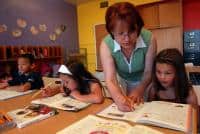
After outgrowing two sites, the school meets alternate Saturdays at the
Parents gather with teachers and children around a table laden with fruit and pastries in the shady courtyard. Many will see each other the following day at church.

„That, and heritage,” she said.
„My little guy goes
to preschool with kids from
The day starts with a prayer. Some students prepare for their First Communion. But religious study is optional; not everyone participates.
The school represents a dream realized for Polish-born Krystyna Chciuk, who made her way to this country after World War II with her husband. They were Polish resistance fighters captured by the Germans after the 1944 Warsaw Uprising and released to
„I knew I couldn’t go home,” Chciuk said. „My husband came from
The school began in increments: She started teaching Polish folk-dancing classes in 1968. The student performances of the Krakowiak in Golden Gate Park attracted so many Polish-American families to her school it rapidly outgrew its space in the 22nd Street Polish Club. In its 40 years and three sites, the school has drawn fourth-generation Poles, the children of Solidarnosc advocates forced out during the Iron Curtain years and newcomers who have never known any but a free
Chciuk retired from teaching after a heart attack.
„I help when they need me,” she said. „My heart is there.”
On the second-to-last day of the school year last week, kids in the religion class crowded around a table and shushed each other. The soft-spoken Rutkowska asked them to identify an icon.
„Czarna Madonna,” called out Andrzej Pabianek.
Oliwia Olano asked why the Madonna in the icon has lines in her cheeks. When enemies of
„It is like a miracle,” Lila said.
Natalia Soja asked whether Mary can talk. Teacher Elzbieta Oleszkiewicz told her yes, she can talk to you in your mind.
Olano asked how many kids Mary had. The teachers twitched, hands hiding stifled titters. „Jesus was a very good kid,” Rutkowska sidestepped. „He worked hard.”
Language study begins with „Elementarz,” the same textbook first-graders use in
„I loved it,” Miluski said.
The challenge is keep each child they range from beginning to fluent stimulated but not overwhelmed.
„I want them to have some fun,” she said. „I think I will be with them in the second grade. We’ll focus more on conversation. We meet 20 days. It’s not that many days.”
Yet they learn quickly and absorb more than it sometimes appears. One boy, on a family vacation to
Evelyn Andrade speaks Spanish and French and is learning Polish „very rapidly,” Miluski said. She won the school’s poetry-reading contest.
High schoolers in a classroom watch slides of a river framed by steep peaks and practice a song for Polish Mother’s Day, which was Monday.
Adam Jroslaw Kodzis’ is the only member of his family who was not born in
He said he makes stronger bonds with his friends at Polish school because there are fewer people, and because they all speak Polish and English.
„Basically, life is extraordinary,” he mused before dashing back into class. „I have to thank my parents because they give me such a happy life even though they came here and struggled to get used to life in
Rebecca Rosen Lum covers religion. Reach her at
A Polish school
The John Paul II School of Polish Language and Culture meets alternate Saturdays from September to June at
Information about the school is at www.polishschool.org.
By Rebecca Rosen Lum
